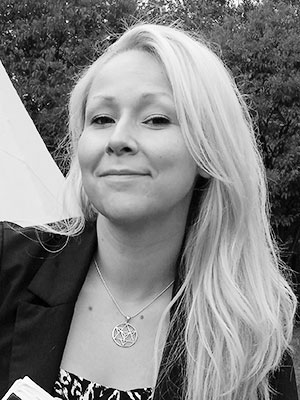PATRICK PALUCKI and MANDY A. SCOTT MyHeadquarters: Novel Neurofeedback Paradigm Through Live EEG In Virtual Reality
Art Tech Demo Concurrent C 8
Abstract Neurofeedback aims to assist individuals in training and maintaining optimal and desired states of consciousness. Brain-computer interfaces (BCIs), originally designed to assist individuals with disabilities (e.g. prostheses), are a type of neurofeedback that use brain signals to control external devices. The development of both neurofeedback and BCI technology has had the potential to transform health and healing, as well as catalyze the acceleration of the ongoing shift in human consciousness, allowing individuals to access an enhanced ability to transform their neuropsychophysiology through intentionality. The problem, however, is that BCI technologies and neurofeedback services are difficult to access due to high cost and limited availability of qualified trainers, restricting its applicability to the elite and wealthy, such as top athletes and professionals. One solution to this ongoing barrier to supporting individual and collective transformations of consciousness is to create new technologies that are scalable to the masses and capable of delivering high quality experiences in neurofeedback. Our concept involves the integration of media-technology, media-art and aesthetics with neuroscience and the science of consciousness. Headquarters is a novel neurofeedback and neurogaming paradigm that employs a multi-channel live EEG system combined with the immersive experience of the virtual reality (VR) space. In this interdisciplinary endeavor, the aim is to create new ways of visualizing brain data in the VR space, an environment that is yet untapped by the world of personal development. This approach provides the user with an immersive experience of walking through their own dynamic state changes. These novel visualizations will be integrated with the principles of neurofeedback and flow to assist the user in cultivating their optimal or desired states, including enhanced creativity, flow, focus, as well as training for the cultivation of both non-dual (meditative) and non-local (distant intentionality) states. www.myheadquarters.co
Patrick Palucki Mandy A. Scott Patrick Palucki, Bio 2016 Patrick Palucki is a media artist, commmunication designer and explorer of consciousness. He creates concepts of novel ways of communication and media application for emerging technologies. He has been long active as an innovator in applications of emerging technologies with f.i. custom-made software tools to create life-visuals like a musician (2000), interactive video-installations in (public) space (2000), video-environments and video-mapping for theatrical performance (2005), ultra-high-res composite photography (2005) and EEG visualizations in VR (2014). Contentwise his output encompasses works on consciousness in the fields of semantics, (sub)cultural mythologies, cybershamanism and neuroscience. In South Asia he spent five years in participant observation at the interface of Hindu-Buddhist and shamanic wisdom traditions, ritual and performance and co-produced several intensives on this topic. He studied media art, visual communication and design at Goldsmiths College, London and University of the Arts, Berlin. His work has been seen internationally on festivals, conferences, in single and group exhibitions and nationally in museal group exhibitions. It has been awarded with the Mandala Award of the European Institute for the Media, the Focus Award of the School of Applied Sciences Dortmund and the Special Prize of the Marler Video Art Award. Palucki also co-authored an operatic performance about climate change for the United Nations’ 60th anniversary in Asia which was performed in the conference hall of the UN headquarters in Bangkok, 2007. Palucki has presented at the conferences “Towards a Science of Consciousness”, Tucson, Arizona, “Science and Nonduality”, San José, California and “Transformative Technology”, Palo Alto, California. He is a visiting member of the Neuroscience Research Group (NRG) led by Dr. Michael Persinger at Lauentian University, Sudbury, Ontario, Canada. Palucki aims to create a novel fusion of consciousness, art & entertainment mediated by neurofeedback-technology.
Mandy A. Scott, Bio 2016 Mandy A. Scott is a consciousness researcher with a background in experimental psychology, neuroscience, and interdisciplinarity. Currently she is completing her doctoral thesis in the interdisciplinary Human Studies program at Laurentian University in Sudbury, Ontario, Canada where her work is supervised by neuroscientist Dr. Michael Persinger. Mandy's research has explored the quantitative electroencephalographic (QEEG) profiles of personal / spiritual development and non-local (psi) practices such as meditation, remote viewing, distant healing, and distant intentionality. Mandy and her colleagues were the first to demonstrate non-local neural synchrony, or excess correlation, between the cerebral activation of pairs of individuals separated by the Atlantic ocean at distances exceeding 6000km. Currently her work is focused on exploring the neural correlates of non-dual (i.e. self-transcendent) and non-local states of consciousness for the development of a novel hybrid-brain-computer-interface system. As part of the new field of Transformative Technology, Mandy aims to standardize the system for engaging neurofeedback and biofeedback for the cultivation of non-dual and non-local states, a process that is well established for mainstream of baseline states (e.g. enhanced focus and calm, reduced anxiety and depression). In her exploration of consciousness Mandy's work is informed by insights gained throughout her own spiritual development journey, which includes the quantum-shamanic world view of her indigenous roots as Mushkegowuk Cree from James Bay, in rural northern Ontario. Mandy employs a method she calls Integral Interdisciplinary, which positions her as both the researcher as well as the subject, informing her ability to develop experimental designs that effectively explore these states of consciousness that have often appeared elusive to traditional measurement in the laboratory. The primary objective of her work is to help people to discover their true self, and to empower people's ability to engage in intentionality for healing as well as personal/spiritual development.
|
|
|||||||||||||


